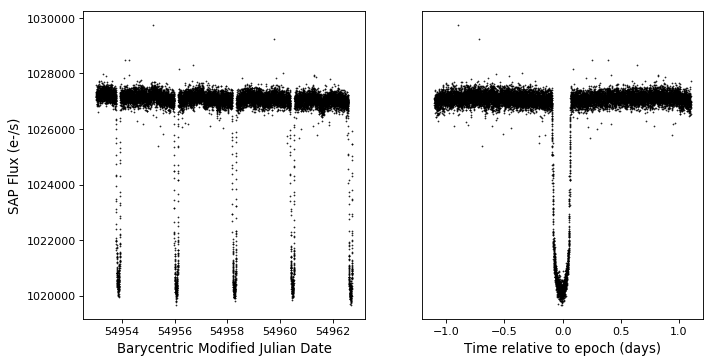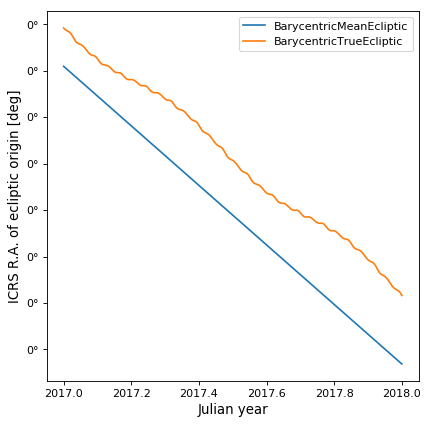What’s New in Astropy 3.2?¶
Overview¶
Astropy 3.2 is a major release that adds significant new functionality since the 3.1.x series of releases.
In particular, this release includes:
- New Sub-package for Time Series
- New SI/CODATA 2018 Constants
- Additions and changes to Ecliptic Transformations
- Table performance improvements and change in meta handling
- Table I/O integration of pandas I/O functions for ASCII tables
- Improved help on Table read() and write() methods
In addition to these major changes, Astropy v3.2 includes a large number of smaller improvements and bug fixes, which are described in the Full Changelog. By the numbers:
- 551 issues have been closed since v3.1
- 256 pull requests have been merged since v3.1
- 67 distinct people have contributed to this release, 24 of which are first time contributors to Astropy
New Sub-package for Time Series¶
Astropy 3.2 includes a new experimental sub-package: Time series (astropy.timeseries). Currently this sub-package provides classes to represent sampled and binned time series as well as some basic analysis tasks.
The following example shows a simple example of reading in a Kepler light curve, finding the period of the transits, and folding the light curve.
import numpy as np
import matplotlib.pyplot as plt
from astropy.timeseries import TimeSeries
from astropy.utils.data import get_pkg_data_filename
from astropy import units as u
filename = get_pkg_data_filename('timeseries/kplr010666592-2009131110544_slc.fits')
ts = TimeSeries.read(filename, format='kepler.fits')
plt.figure(figsize=(10,5))
# Show the original light curve
plt.subplot(1, 2, 1)
plt.plot(ts.time.mjd, ts['sap_flux'], 'k.', markersize=1)
plt.xlabel('Barycentric Modified Julian Date')
plt.ylabel('SAP Flux (e-/s)')
# Find the transit period and fold the light curve
from astropy.timeseries import BoxLeastSquares
periodogram = BoxLeastSquares.from_timeseries(ts, 'sap_flux')
results = periodogram.autopower(0.2 * u.day)
best = np.argmax(results.power)
ts_folded = ts.fold(period=results.period[best],
midpoint_epoch=results.transit_time[best])
# Show the folded light curve
plt.subplot(1, 2, 2)
plt.plot(ts_folded.time.jd, ts_folded['sap_flux'], 'k.', markersize=1)
plt.xlabel('Time relative to epoch (days)')
plt.gca().get_yaxis().set_visible(False)

This sub-package should be considered experimental and subject to API changes in the future if user feedback calls for it.
Note that the LombScargle and
BoxLeastSquares periodogram classes have now moved
from the astropy.stats to the astropy.timeseries module. These
classes have been improved and can now take absolute times as an alternative
to relative times.
Finally, the LombScargle class now includes a
model_parameters() method to make it easier to
compute the best-fit parameters for a given frequency, as well as
design_matrix() and
offset() to inspect the model further.
New SI/CODATA 2018 Constants¶
The new redefinition of the SI system and its base units came into force on 2019-05-20. Accompanying that redefinition was a new set of physical constants (CODATA2018). Astropy v3.2 contains these new CODATA2018 phsical constants, which contain in particular quite different uncertainties due to the redefinition. E.g.,:
>>> from astropy import constants
>>> from astropy.constants import codata2018
>>> constants.m_e
<<class 'astropy.constants.codata2014.CODATA2014'> name='Electron mass' value=9.10938356e-31 uncertainty=1.1e-38 unit='kg' reference='CODATA 2014'>
>>> constants.m_e.uncertainty, codata2018.m_e.uncertainty
(1.1e-38, 2.8e-40)
>>> constants.mu0.uncertainty, codata2018.mu0.uncertainty
(0.0, 1.9e-16)
While CODATA2018 will not be the default in astropy v3.2, a future version will transition to the new values (with units similarly matched where relevant).
For more background on the values and measurements of these constants see the CODATA web site, or see the wikipedia article on the new SI system for a more accessible description of the revised system.
Additions and changes to Ecliptic Transformations¶
The Ecliptic frames and associated transformations in
astropy.coordinates
have been updated to correctly reflect the “True” and “Mean” terminology. In
this release there are now *MeanEcliptic frames now which include precession but
not nutation, and *TrueEcliptic frames which also include nutation.
Additionally, new frames (HeliocentricEclipticIAU76 and
CustomBarycentricEcliptic) have been added with specific
conventions used in particular fields. For more details on the motivation behind
these changes, see PR #8394
and the associated discussion.
As an example, this shows the evolution of the ecliptic origin for the true and mean barycentric ecliptic frames over the course of a year:
import numpy as np
import matplotlib.pyplot as plt
from astropy.visualization import quantity_support
quantity_support()
from astropy import units as u
from astropy.time import Time
from astropy.coordinates import BarycentricMeanEcliptic, BarycentricTrueEcliptic, ICRS
t = Time('J2018') + np.linspace(-1, 0, 1000)*u.year
bme_origin = BarycentricMeanEcliptic([0]*len(t)*u.deg, [0]*len(t)*u.deg, equinox=t)
bte_origin = BarycentricTrueEcliptic([0]*len(t)*u.deg, [0]*len(t)*u.deg, equinox=t)
im = bme_origin.transform_to(ICRS())
it = bte_origin.transform_to(ICRS())
plt.plot(t.jyear, im.ra.wrap_at(180*u.deg), label='BarycentricMeanEcliptic')
plt.plot(t.jyear, it.ra.wrap_at(180*u.deg), label='BarycentricTrueEcliptic')
plt.xlabel('Julian year')
plt.ylabel('ICRS R.A. of ecliptic origin [{}]'.format(im.ra.unit))
plt.legend(loc=0)

Note that this change may break some usage of the previous *TrueEcliptic
frames, as in the last few versions these had a behavior more akin to “mean”
ecliptic frames. In many cases it will be sufficient to simply replace this
usage with the appropriate *MeanEcliptic frames.
Default time scale for “J2000”-style strings changed to TT¶
In past versions of astropy, times specified as “equinox-style strings” - e.g.,
Time('J2000') - defaulted to the UTC scale. This includes default equinoxes
for FK4/FK5 coordinates. To be more consistent with commonly-accepted usage of
terms like “J2000”, this strings now default to the TT time scale. This
difference is on the order of 60 seconds, which for e.g. equinox precession is
typically an extremely small differences (picoarcseconds). However, if the
previous behavior is needed, the easiest work-around is to change any use of
e.g., 'J2000' to Time('J2000', scale='utc').
Table performance improvements and change in meta handling¶
A number of changes were made to the Table implementation to
improve performance:
- Table row access speed is improved by a factor of 2 to 3.
- Table slicing speed is improved by a factor of 2.
- Getting the table length is now faster by a factor of 3 to 10.
- Writing a table with masked columns to ECSV is now faster (depending on how many masked columns there are).
- Manipulating tables and columns that have substantial meta-data stored in
the
metaattributes (e.g. some FITS tables) is now faster. This was done by removing unnecessary deep copies of the meta-data and in some cases converting to a shallow copy. See the change log for #8404 for details about the related API changes in table initialization and slicing.
Table I/O integration of pandas I/O functions for ASCII tables¶
Astropy Table now supports the ability to read or write tables
using some of the
I/O methods
available within pandas. This interface provides
convenient wrappers for the pandas read/write
functions for the following formats: CSV, JSON, HTML, and fixed width.
For very large tables these may provide better performance than the built-in
astropy table ASCII read and write functions. For details see Pandas.
Support for ASDF readers/writers for Table class¶
If the asdf package is installed,
Table can be read from and written to
ASDF files, using e.g.:
from astropy.table import Table
tab = Table.read('data.asdf')
and:
tab.write('table.asdf')
Improved help on Table read() and write() methods¶
Starting from astropy version 3.2 is now possible to get detailed help for
read and write which is
specific to a particular data format. This includes information about
the format and method keywords that apply only for that format. The
following examples illustrate the new syntax for getting help:
>>> Table.read.help('ascii.latex')
>>> Table.read.help('ascii')
>>> Table.read.help('fits')
>>> Table.write.help('hdf5')
>>> Table.write.help('csv')
>>> Table.read.help() # Generic read help
Deprecated/Renamed/Removed functionality¶
The bundled version of the six package in
the astropy.extern.six sub-package is now deprecated. You should instead
make use of the six package directly.
Composition of model classes (as opposed to instances) is now deprecated and will be removed in the v4.0 release.
The LombScargle and
BoxLeastSquares periodogram classes have now moved
from the astropy.stats to the astropy.timeseries module.
The previously deprecated astropy.tests.pytest_plugins module has been
removed. The variables PYTEST_HEADER_MODULES and TESTED_VERSIONS should
instead be imported from astropy.tests.plugins.display, and the function
enable_deprecations_as_exceptions should be imported from
astropy.tests.helper.
Full change log¶
To see a detailed list of all changes in version v3.2, including changes in API, please see the Full Changelog.
Contributors to the v3.2 release¶
|
|
|
|
Where a * indicates their first contribution to Astropy.